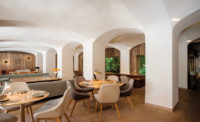The Suite Spot
While conformity used to guide hospitality design, now original expression and a strong sense of place inspire hotel architecture.

Photo © Michel Arnaud
Anyone who travels has seen how dramatically the design of new hotels has changed. And if you’ve worked on hotel design yourself, you know firsthand that distinctiveness is now the mantra in this thriving building type, for which the number of new hotel projects was up 8 percent last year.
Even the big chains have introduced unique designer hotels to their portfolios, such as Amsterdam’s Andaz (a Hyatt brand) by Marcel Wanders, or the JW Marriott Venice Resort & Spa by Matteo Thun & Partners. While such behemoths dominate the business, beautifully designed hotels from smaller companies with their own character and connection to place—not unlike the locavore food movement—are appealing to more travelers, including Millennials. As one trade publication has reported, “Uniformity no longer sells.”
At RECORD, we’ve regularly covered the best in hospitality design, and, for this issue, we sent design writers to visit a half-dozen unique new hotels, in places ranging from Rio de Janeiro to Hong Kong, where they explored the architecture of guest rooms, bars, dining rooms, lounges, and spas. They also reported on how these one-of-a-kind buildings fit into the surrounding cityscape or countryside. One way such establishments are woven into the local fabric reflects another trend: increasingly, hoteliers are looking to transform older structures that had a prior, different use.
Two hotels in the pages ahead were originally government office buildings from the 1960s. The Dewberry Charleston in South Carolina was a seven-story Modernist structure for Federal agencies. When it was abandoned, a developer bought it from the GSA, and local architect Reggie Gibson, in partnership with the developer’s in-house design team, adapted it to new life, with interiors by Brooklyn-based Workstead Studio, the firm behind that borough’s uber-chic Wythe Hotel. In Hong Kong, Foster + Partners has converted the 27-story Murray Building, once home to the city’s Public Works Department, into a luxury hotel in the center of town. In doing so, the architects had to rethink a complicated sequence of entrances, ramps, and car access on the steeply sloped site. The architects of both hotels added rooftop social spaces with stunning views.
Whether old structures or new, the best small hotels seek to find the genius loci. While the first Ace Hotel to open in Chicago is almost all new construction, it’s designed to fit snugly into the gritty historic fabric of the rapidly gentrifying Fulton Market neighborhood. For its first hospitality project in Copenhagen, Nobis Hospitality Group chose an early 20th-century Neoclassical company headquarters, with superb assets—large windows, a majestic central stair, and lots of marble—to convert into an elegant city retreat. In a rustic village in Northern Italy, architect Piero Lissoni added a wing to a 200-year-old house to create a small gem (just 11 rooms) that is all about privacy, quiet gardens, light, and extraordinary vistas of Lake Orta. The complete opposite of that secluded and romantic getaway is the jazzy Emiliano in Rio—the ground-up 90-room hotel by Studio Arthur Casas and Oppenheim Architecture—overlooking Copacabana beach and the richly patterned Promenade designed by Roberto Burle Marx. Here is a sense of pure fun, with the building’s facade covered in white perforated panels that can fold open to reveal guest room balconies, while a rooftop pool with a glazed exterior wall makes swimmers part of the amazing cityscape.
What’s striking these days is that hotel guests don’t seem to mind bedrooms that are simple and often small—though with luxurious touches—while they increasingly want well-designed and richly varied public spaces to meet, mingle, and relax. Midcentury Modern furniture is in danger of becoming a cliché in such interiors, but the overall aesthetic, with woods and soft furnishings, creates an ambience that is less corporate and more cozy; less disco and more domestic (three of these hotels call their lounges the “living room”).
While many travelers will still seek the familiar comfort of conformity, more architects are designing for the growing cohort who prefer a hotel like nowhere else, that beautifully responds to the local culture and setting, while catering, of course, to every little desire. Smart, imaginative design is essential to creating those ultimate getaway places.



